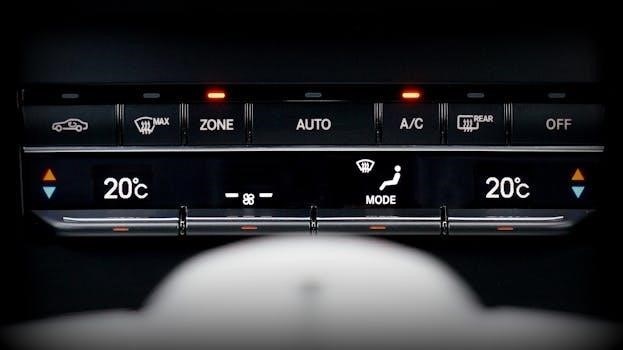Understanding Fahrenheit to Celsius Conversion
Converting temperatures between Fahrenheit and Celsius is essential for various applications, requiring a clear grasp of the conversion process. This section provides an overview of the underlying principles, detailing how the two scales relate and how to accurately perform the conversion.
The Basic Formula for Conversion
The fundamental formula to convert Fahrenheit (°F) to Celsius (°C) involves a straightforward mathematical process. The core principle is to first account for the offset in the zero points of the two scales and then adjust for the difference in the magnitude of each degree. The formula is expressed as⁚ C = (F ⎼ 32) × 5/9. This formula subtracts 32 from the Fahrenheit temperature, which aligns the freezing point of water at 0°C, and multiplies the result by 5/9 to reconcile the different sizes of the degree increments in the two scales. Conversely, if converting from Celsius to Fahrenheit the formula would be F= (C * 9/5) +32. The conversion factor of 5/9 arises from the fact that the range between the freezing and boiling points of water is divided into 180 equal parts in Fahrenheit but 100 in Celsius. This formula is crucial for accurately converting temperature readings from one scale to the other. It is essential for consistent data interpretation.
Step-by-step calculation
To accurately convert Fahrenheit to Celsius, follow these steps using the formula C = (F ⸺ 32) × 5/9. First, identify the temperature in Fahrenheit that you need to convert. Then, subtract 32 from this value. This step corrects for the difference in the zero points of the two temperature scales. Next, multiply the result of the subtraction by 5. This is part of adjusting for the different sizes of the degree increments. Finally, divide the product from the multiplication by 9. This final step completes the adjustment, giving you the temperature in Celsius. For example, to convert 70°F, calculate (70 ⸺ 32) = 38. Then, multiply 38 by 5, giving 190, and divide 190 by 9, resulting in approximately 21.11°C. This step-by-step method ensures accurate conversion between the two scales. Each step is vital for correct calculation.

Fahrenheit to Celsius Conversion Table
A conversion table offers a quick way to find Celsius temperatures without calculations. This table provides a range of Fahrenheit values and their corresponding Celsius equivalents, facilitating easy temperature conversions.
Table for Common Temperatures
This table focuses on frequently encountered temperatures, offering a practical reference for everyday use. It includes values ranging from below freezing to typical room temperatures and beyond, providing a clear Celsius equivalent for each Fahrenheit reading. The table is designed to be easy to read, helping users quickly find the conversion they need without resorting to manual calculations. For example, common temperatures such as 32°F (freezing point of water) are shown along with their corresponding 0°C value. The table also includes temperatures often experienced in daily life, such as 68°F (approximately 20°C), a standard room temperature, and 98.6°F, the average human body temperature (which is 37°C). This practical table ensures users can easily reference the Celsius equivalent of common Fahrenheit temperatures.
Extended Conversion Table
The extended conversion table offers a comprehensive range of temperature conversions, going beyond the common values. It is designed to cater to more specific needs, providing a detailed reference for a broader range of temperatures. This table covers a wider spectrum, from very low temperatures to higher values, allowing users to find the precise Celsius equivalent for any Fahrenheit temperature within its range. The extended table includes temperatures below freezing and well above the boiling point of water, making it suitable for scientific or industrial applications. For instance, values such as -17.78°C (0°F) are listed, along with temperatures ranging up to 260.6°C (501°F). This extensive resource is vital for those requiring precise and accurate temperature conversions across a broader spectrum, ensuring accurate data for varied needs.
Printable PDF Resource
A printable PDF resource offers a convenient and accessible way to keep a Fahrenheit to Celsius conversion chart on hand. This downloadable document is designed for ease of use and can be printed for quick reference without needing an internet connection. The PDF chart is formatted clearly, making it simple to read and use for a variety of purposes, from home cooking to scientific research. It eliminates the need for online tools, providing a handy physical resource. This resource includes a well-organized table with a range of Fahrenheit temperatures and their corresponding Celsius values, ensuring accurate conversions when needed. It is a valuable tool for those who prefer having a hard copy of the conversion chart available at any time.
Using the Conversion Chart
The conversion chart serves as a quick reference guide, simplifying the process of switching between Fahrenheit and Celsius. It is designed for ease of use, offering clear and direct temperature equivalents.
Quick Reference Guide
This quick reference guide is designed to offer immediate access to common temperature conversions between Fahrenheit and Celsius. Instead of memorizing formulas, you can quickly find the equivalent temperature using this chart. It provides a straightforward approach, perfect for everyday use, whether you’re in the kitchen, checking the weather, or working on a scientific project. The guide is structured to be easily readable, allowing you to find the corresponding temperature on either scale within seconds. It is an essential tool for anyone who frequently works with both Fahrenheit and Celsius, offering a simple and efficient way to switch between the two without manual calculations. Having a readily available reference eliminates the need for complex calculations, making it a very time-saving tool. This section focuses on the practical use of this guide, ensuring that you can quickly and accurately find the temperature you need.
Practical Examples
To demonstrate the usefulness of the Fahrenheit to Celsius conversion chart, consider a few practical examples. Imagine you’re baking a cake and the recipe requires an oven temperature of 350°F, but your oven displays temperatures in Celsius. Using the chart, you quickly identify that 350°F is approximately 177°C. This quick conversion helps you to set your oven accurately and get the best baking results. Similarly, if the weather forecast predicts a high of 86°F, you can use the chart to find that this is about 30°C, helping you plan your day accordingly. Furthermore, if you’re traveling to a country where Celsius is used, the chart helps you to understand the local temperatures. These real-world scenarios highlight how the conversion chart simplifies everyday temperature adjustments, making it a valuable tool for anyone dealing with both scales. It also shows how the chart makes the use of both scales accessible and easy for everyone.

Key Temperatures in Both Scales
Understanding critical temperature points in both Fahrenheit and Celsius is crucial. This section outlines key temperatures like water’s freezing and boiling points and average human body temperature, presented in both scales.
Freezing and Boiling Points of Water
Water’s freezing and boiling points are fundamental reference temperatures, differing significantly between the Fahrenheit and Celsius scales. In Celsius, water freezes at 0°C and boils at 100°C, establishing a straightforward scale based on the properties of water. Conversely, on the Fahrenheit scale, water freezes at 32°F and boils at 212°F. These disparities underscore the need for accurate conversion methods when working between these two temperature systems. The differing values for these key points reflect the varied scaling and origins of each temperature measurement system, which is important to understand when converting temperatures. A clear understanding of these points is vital for scientific applications, cooking, and everyday life, ensuring that temperature is accurately measured and communicated. The difference is also very clear on any fahrenheit to celsius chart pdf.
Average Human Body Temperature
The average human body temperature is another crucial reference point, typically measured at approximately 98.6°F, which converts to 37°C. This value, while considered the norm, can fluctuate slightly based on various factors like activity level, time of day, and individual differences. It’s important to note that minor variations above or below this average are generally considered normal, but significant deviations might indicate a medical condition. Understanding the average human body temperature in both Fahrenheit and Celsius is especially vital in healthcare settings for accurately assessing a patient’s health status; Many fahrenheit to celsius charts pdf will use this temperature as an example to illustrate the conversion process. This knowledge is essential for medical professionals and anyone monitoring their health, ensuring accurate temperature readings and proper interpretation.

Conversion Tools
Various tools are available to facilitate Fahrenheit to Celsius conversions, ranging from online calculators to manual methods. These tools enable quick and accurate temperature translations for diverse needs.
Online Calculators
Numerous online calculators offer instant Fahrenheit to Celsius conversions, simplifying the process and eliminating the need for manual calculations. These tools are readily accessible through websites and mobile apps, providing a user-friendly interface for temperature conversions. Users can input a Fahrenheit value, and the calculator will promptly display the equivalent Celsius temperature. Many online calculators also include reverse functionality, allowing for Celsius to Fahrenheit conversions. Some advanced calculators feature additional options, such as displaying the conversion formula and providing a history of past calculations; These tools are especially valuable when a quick and precise conversion is necessary without the need to remember the formula or perform calculations by hand. They are free to use and do not require any special software installations, making them a very handy resource for users of all technical skill levels. Furthermore, some calculators allow you to display results to a specific number of decimal places.
Manual Calculation Methods
While online calculators offer convenience, understanding manual calculation methods provides a deeper understanding of the conversion process. The fundamental formula for converting Fahrenheit to Celsius involves subtracting 32 from the Fahrenheit temperature and then multiplying the result by 5/9. This formula, (F ⎼ 32) * 5/9 = C, allows for accurate conversions using simple arithmetic. Alternatively, one can divide by 1.8, since 5/9 is approximately 0.5555 and 1/0.5555 is 1.8. To perform the conversion manually, first subtract 32 from the Fahrenheit value. Then multiply this new value by 5 and divide by 9, or simply divide by 1.8. Although this calculation is a bit more complex than adding or subtracting, a calculator or pen and paper can be used. This approach enables users to perform conversions without relying on external tools and reinforces the mathematical relationship between the two scales. It is helpful to understand this to learn the conversion process more thoroughly.

Additional Resources
To further assist with temperature conversions, this section provides links to downloadable PDF charts and other useful temperature converters. These resources will help with your conversion needs.
Downloadable PDF Charts
For convenient offline access, we offer a selection of downloadable PDF charts that provide a comprehensive reference for converting temperatures between Fahrenheit and Celsius. These charts are designed for easy printing and can be used in various settings, such as kitchens, laboratories, or educational environments. Each PDF chart contains a detailed table, listing Fahrenheit temperatures alongside their corresponding Celsius equivalents. The charts cover a wide range of temperatures, from well below freezing to well above boiling points, ensuring you have the necessary information for a wide range of applications. These downloadable charts are especially useful for those who prefer a tangible reference tool or need a quick conversion guide without relying on an internet connection. They are formatted for clear readability and are available in multiple styles, allowing you to choose the layout that best suits your needs. These resources are perfect for students, professionals, or anyone needing a reliable temperature conversion reference at their fingertips. Print and keep them handy for quick temperature conversions.
Other Useful Temperature Converters
Beyond simple charts, a variety of temperature converters are available to facilitate precise and quick conversions between Fahrenheit and Celsius. Online tools, such as those provided by various websites, offer interactive calculators where users can input a temperature in one scale and instantly obtain the equivalent in the other. These converters often include advanced features, such as the ability to convert decimal values, thus providing greater accuracy. Furthermore, some smartphone apps and software applications offer real-time temperature conversion capabilities. These digital tools are particularly useful for those who require frequent and precise temperature conversions in various professional or personal contexts. These converters offer a quick and efficient way to get the results, while some also offer additional features like storing previous results. These resources are invaluable for anyone needing temperature conversions with a high degree of precision and speed. They provide user-friendly interfaces and are accessible across multiple devices.
